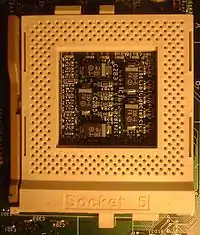Socket 5
Socket 5 was created for the second generation of Intel P5 Pentium processors operating at speeds from 75 to 133 MHz[1][2] as well as certain Pentium OverDrive and Pentium MMX processors with core voltage 3.3 V. It superseded the earlier Socket 4. It was released in March 1994.[3] Consisting of 320 pins, this was the first socket to use a staggered pin grid array, or SPGA, which allowed the chip's pins to be spaced closer together than earlier sockets. Socket 5 was replaced by Socket 7 in 1995.[4]
 | |
| Type | ZIF |
|---|---|
| Chip form factors | SPGA |
| Contacts | 320 |
| FSB protocol | proprietary |
| FSB frequency | 50, 60, or 66 MT/s |
| Voltage range | 3.1 to 3.6 V |
| Processors | Intel P5 Pentium (75 - 133 MHz) Intel Pentium Overdrive (125 - 180 MHz) Intel Pentium Overdrive MMX (125 - 200 MHz) AMD K5 (PR75 - PR200) IDT WinChip (180 - 200 MHz) IDT WinChip-2 (200 - 240 MHz) IDT WinChip-2a (233 MHz) and compatible |
| Predecessor | Socket 4 |
| Successor | Socket 7 |
This article is part of the CPU socket series | |
External links
- Differences between Socket 5 and Socket 7 (archived)
References
- "Pentium OverDrive Processor Socket Specification: Introduction". Intel Pentium Processor Family Developer's Manual (PDF). Intel. September 22, 1997. p. 17-1. Archived from the original (PDF) on October 14, 2011. Retrieved September 21, 2011.
Socket 5 has been defined for the Pentium processor-based systems with core frequencies from 75 MHz to 120 MHz.
- "OverDrive Processor Socket Specification: Socket 5". Datasheet for Intel Pentium processor 75/90/100/120/133/150/166/200 (PDF). Intel. September 22, 1997. p. 69. Retrieved September 21, 2011.
Socket 5 does not support upgradability for 133 MHz or higher processors.
- Torres, Gabriel. "A Complete List of CPU Sockets". Hardware Secrets. Archived from the original on 24 September 2014. Retrieved 23 September 2014.
- Intel Socket 5 Specification, pcguide.com, retrieved 2009-03-31
This article is issued from Wikipedia. The text is licensed under Creative Commons - Attribution - Sharealike. Additional terms may apply for the media files.